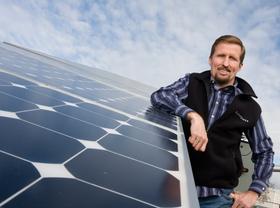The head of US-based solar giant SunPower says Australia has the potential to be at the cutting edge of the global shift towards decentralised, or local, energy generation, as solar costs continue to fall and battery storage is deployed to balance supply and demand.
Tom Werner, the CEO of the California-based SunPower, one of the two biggest solar manufacturers and project developers in the US with a market capitalisation of $US4 billion, says the combination of good sun, open spaces, and high electricity costs make Australia one of the most attractive markets in the world for solar. But he warns that constant shifting on policies will cause costs to rise, rather than fall.
 “Solar makes sense here,” Werner said in an interview in Sydney with RenewEconomy. “The economics of solar work better in Australia than in most places in America,” where the long-term trend in solar is clear because the economics are also so strong.
“Solar makes sense here,” Werner said in an interview in Sydney with RenewEconomy. “The economics of solar work better in Australia than in most places in America,” where the long-term trend in solar is clear because the economics are also so strong.
“The horse is out of the barn already in the US … and it is the same thing here. It is hard to put the genie back into the bottle. People want solar and it is economic, so it is going to happen. The question is how do you get there?”
That question has caused a massive pushback from incumbent generators – in Australia, the US and Europe – about the growth of distributed solar, and triggered a massive regulatory wrestling match about how solar should be priced.
Werner says it is important to understand what is actually driving the economics, and to appreciate that solar “actually does work” – a message not always shared by the incumbents. But as the world saw with the arrival of wireless communications and then with smart phones, incumbents will always resist.
“The consumer has got to win. If consumers win, then you have true north and that will drive policy,” Werner says.
“It feels like the (Australian political) goal is a good goal, which is to build a system that does not put the prices up. That’s a good goal, the question is how you get there. It seems like that if the cost of solar is coming down, then attacking solar is probably not the best way to get costs down.”
Werner this week will speak at the Energy Networks Association conference in Melbourne, a meeting of network operators who are facing the biggest challenge to their business models in more than a century of relying on centralised generation, and a network of poles and wires. All are struggling with the new concept, although there is now greater recognition that the new technology is here to stay
“We do not know how it will evolve. It will be messy, that’s what we do know,” Werner says. “But it is great to be in our position because we are a disruptor. We do have to continue to get costs our out, that’s our messy side of it, and to create systems that match generation with demand.”
Werner notes the policy uncertainty in Australia, and the rhetoric around renewable technologies, particularly solar. He says there is a similar push-back in the US, where incumbents are trying to force regulatory and policy change.
“What you have here is very similar to American politics; there are soundbites that people want to hear rather than (understanding) actually what is driving the economics.
“The challenge is in balancing supply and demand. Australia could be a leading edge for how to do distributed generation and match supply and demand. Australia can be the front end of the market.
“Add to that the issue of fuel price risk. Sunshine is free, and Australia is a great proof point for natural gas price risk, as the (LNG exports) push price up. That creates a great market stimulus.”
The key to matching supply and demand will be in energy storage. Werner says developments like the Tesla “Gigafactory” will be a game changer and will help bring costs down. He says battery storage is at a similar stage to solar five years ago, just before its massive cost fall.
SunPower itself is looking at deploying systems that combine solar PV and storage and will soon announce its first pilot schemes in Australia, likely to be rolled out through its partly owned local retailer Diamond Energy. It is also looking at microgrid solutions in Australia, although it sees the biggest potential in the commercial rooftop market.
SunPower is also building the world’s biggest solar PV “merchant” plant, which means it is being financed without a power purchase agreement and will compete with other fuels on the spot market. That is being built in Chile and Werner says that other markets will follow – although probably not Australia, for the moment, because of the low wholesale price.
(Editor’s note: We will run the full interview with SunPower’s Werner on Wednesday).







